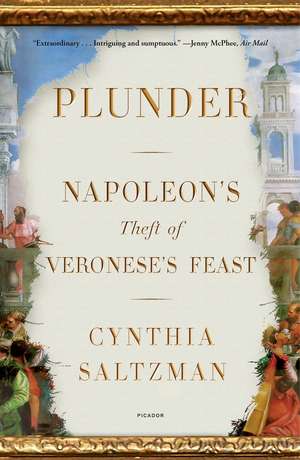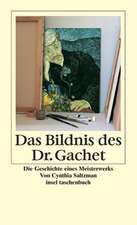Plunder
Autor Cynthia Saltzmanen Limba Engleză Paperback – 17 mai 2022
"A highly original work of history . . . [Saltzman] has written a distinctive study that transcends both art and history and forces us to explore the connections between the two." -Roger Lowenstein, The Wall Street Journal
A captivating study of Napoleon's plundering of Europe's art for the Louvre, told through the story of a Renaissance masterpiece seized from Venice
Cynthia Saltzman's Plunder recounts the fate of Veronese's Wedding Feast at Cana, a vast, sublime canvas that the French, under the command of a young Napoleon Bonaparte, tore from a wall of the monastery of San Giorgio Maggiore, on an island in Venice, in 1797. Painted in 1563, the Renaissance picture had been immediately hailed as a masterpiece. Veronese had spread the scene across the end wall of the monastery's refectory and filled it with some 130 figures, lavishing color on the canvas to build the illusion that the biblical banquet was taking place on a terrace in sixteenth-century Venice. Once it was pulled from its frame, the canvas crossed the Mediterranean rolled on a cylinder, bound for Paris; soon after, artworks commandeered in Venice and Rome were triumphantly brought to the French capital. In 1801, the Veronese went on exhibition at the Louvre, the new public art museum founded during the Revolution, in the former palace of the French kings.
As Saltzman tells the larger story of Napoleon's looting of Italian art and its role in the creation of the Louvre, she reveals defining traits of his character: his desire for greatness and his ruthlessness in getting whatever he sought. After Napoleon's defeat at Waterloo in 1815, the Duke of Wellington and the Allies forced the French to return many of the paintings and sculptures they had seized. Nevertheless, the French resisted sending The Wedding Feast at Cana back to Venice, and the painting remains in Paris to this day, hanging directly opposite the Mona Lisa.
Expertly researched and deftly told, Plunder chronicles one of the most spectacular art-appropriation campaigns in history, shedding light on a seminal historical figure and the complex origins of one of the world's great museums.
Preț: 108.37 lei
Nou
Puncte Express: 163
Preț estimativ în valută:
20.74€ • 21.73$ • 17.14£
20.74€ • 21.73$ • 17.14£
Carte indisponibilă temporar
Doresc să fiu notificat când acest titlu va fi disponibil:
Se trimite...
Preluare comenzi: 021 569.72.76
Specificații
ISBN-13: 9781250861481
ISBN-10: 1250861489
Pagini: 336
Dimensiuni: 134 x 207 x 25 mm
Greutate: 0.43 kg
Editura: Pan Macmillan
ISBN-10: 1250861489
Pagini: 336
Dimensiuni: 134 x 207 x 25 mm
Greutate: 0.43 kg
Editura: Pan Macmillan
Notă biografică
Cynthia Saltzman is the author of Portrait of Dr. Gachet: The Story of a Van Gogh Masterpiece and Old Masters, New World: America's Raid on Europe's Great Pictures. A former reporter for Forbes and The Wall Street Journal, she is the recipient of a fellowship from the Guggenheim Foundation and has degrees in art history from Harvard and the University of California at Berkeley. She lives in Brooklyn, New York.
Cuprins
Introduction: "One of the greatest [paintings] ever made with a brush"
1. "Send me a list of the pictures, statues, cabinets and curiosities"
2. Venice need not "fear that the French Armies would not fully respect its neutrality"
3. "Master Paolo will . . . not spare any expense for the finest ultramarine"
4. "He is rich in plans"
5. "This museum must demonstrate the nation's great riches"
6. "Draw as much as you can from Venetian territory"
7. "The Pope will deliver . . . one hundred paintings, busts, vases or statues"
8. "I'm on a path a thousand times more glorious"
9. "The Republic of Venice will surrender . . . twenty paintings"
10. "In the Church of St. George . . . The Wedding Feast at Cana"
11. "We . . . have received from Citizen Pietro Edwards"
12. "The most secure way would be to send them on a frigate, with 32 cannons"
13. "The seam . . . will be unstitched"
14. "The Revolution . . . is finished"
15. "You enter a gallery-such a gallery. But such a gallery!!!"
16. "The transparency of air . . . place[s] Gros beside Tintoretto and Paul Veronese"
17. "This beautiful work reminds us of the picture by Paul Veronese"
18. "I succeeded . . . in packing most of the pieces of small size and great value"
19. "The only thing to do is to burn them!"
20. "This foreboding painting . . . seems to summon the eye . . . from all directions"
21. "The masterpieces of the arts now belong to us"
22. "We are at last beginning to drag forth from this great cavern of stolen goods the precious objects of Art"
Epilogue
Notes
Selected Bibliography
Acknowledgments
Index
1. "Send me a list of the pictures, statues, cabinets and curiosities"
2. Venice need not "fear that the French Armies would not fully respect its neutrality"
3. "Master Paolo will . . . not spare any expense for the finest ultramarine"
4. "He is rich in plans"
5. "This museum must demonstrate the nation's great riches"
6. "Draw as much as you can from Venetian territory"
7. "The Pope will deliver . . . one hundred paintings, busts, vases or statues"
8. "I'm on a path a thousand times more glorious"
9. "The Republic of Venice will surrender . . . twenty paintings"
10. "In the Church of St. George . . . The Wedding Feast at Cana"
11. "We . . . have received from Citizen Pietro Edwards"
12. "The most secure way would be to send them on a frigate, with 32 cannons"
13. "The seam . . . will be unstitched"
14. "The Revolution . . . is finished"
15. "You enter a gallery-such a gallery. But such a gallery!!!"
16. "The transparency of air . . . place[s] Gros beside Tintoretto and Paul Veronese"
17. "This beautiful work reminds us of the picture by Paul Veronese"
18. "I succeeded . . . in packing most of the pieces of small size and great value"
19. "The only thing to do is to burn them!"
20. "This foreboding painting . . . seems to summon the eye . . . from all directions"
21. "The masterpieces of the arts now belong to us"
22. "We are at last beginning to drag forth from this great cavern of stolen goods the precious objects of Art"
Epilogue
Notes
Selected Bibliography
Acknowledgments
Index






